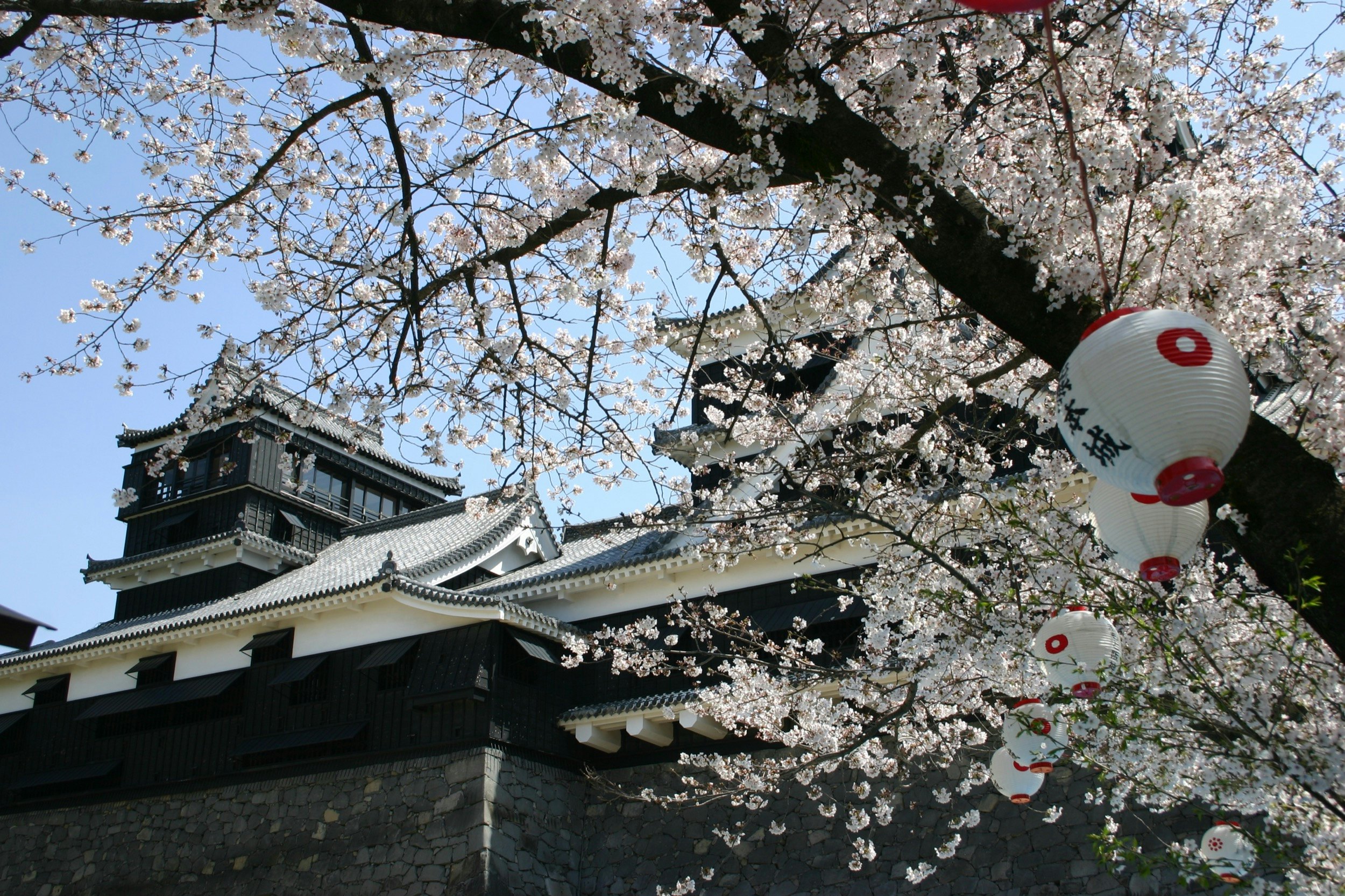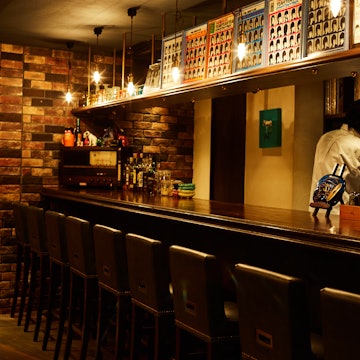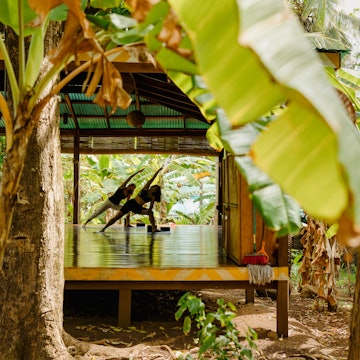
Kumamoto City: the perfect base for cultural experiences on Kyushu
Sponsored by
Dec 21, 2021 • 6 min read

Kumamoto is the perfect place to learn about Japan’s cultural traditions, and a convenient base from which to explore the wealth of natural wonders nearby © Getty Images
Kumamoto, a modern Japanese city in west-central Kyushu, is justifiably proud of its roots as a medieval castle town (jokamachi). It’s the perfect place to learn about Japan’s cultural traditions, and a convenient base from which to explore the wealth of natural wonders nearby – including Mt. Aso, one of Japan’s most active volcanoes.

Kumamoto Castle: the beating heart of the city
In April 2016 television screens around the world showed news footage of the 400-year-old stone walls at Kumamoto Castle sliding and crumbling, victims of a once-in-a-century earthquake. All thirteen of the castle buildings, which are national important cultural properties, were damaged or destroyed.
Within two weeks the city had begun to shore up the beloved but damaged castle and make restoration plans. Full restoration is expected to take another 15 years, but Kumamoto Castle has been re-opened to visitors via catwalks around the damaged walls, allowing access to limited sections of the castle grounds and the opportunity to view both the damage and the ongoing repair work. Each other building is being re-opened as work is completed.
The castle’s keep, distinctive for its two towers, was re-opened to the public in summer 2021. Inside is a fascinating museum with information on the various stages of the castle’s history. There you’ll learn about feudal warlord Kiyomasa Kato (1562-1611), who designed his castle to be impregnable and siege-proof, with steep stone walls as high as about 20m and as many as 120 deep wells to ensure a steady water supply.

According to legend, he also planted ginkgo trees around the castle grounds to ensure an emergency food supply in case of siege. One those trees, now enormous, stands in front of the keep, its golden leaves exceptional in autumn.
Head to the top floor of the keep for a panoramic view of the city and the surrounding countryside. On a clear day, you can even see smoke rising from the Mt. Aso volcano some 50km to the east.
The seasons are honored and celebrated across Japan, and Kumamoto Castle is particularly well positioned to appreciate the autumn leaves and spring blossoms. The castle grounds are especially popular during cherry blossom season, when nearly 800 cherry trees turn the landscape a gentle pink as the castle’s black keep looms above.

Experience traditional crafts
Over the centuries, artisans in each of Japan’s castle towns developed traditional crafts to please their feudal lord and his entourage. One of the most famous is damascene, known in Japanese as Higo Zogan. Historically, these intricate designs of inlaid gold and silver were used to decorate sword and gun handles and other items used by samurai warriors. Today, most Higo Zogan adorns jewelry and personal items such as pens, hand mirrors and letter- openers.
To try your hand at Higo Zogan, look for Mitsusuke, a workshop in the Shinmachi district just below the castle. Here, fourth-generation artisan Yuji Osumi guides visitors through the
experience of pounding gold leaf onto a black iron base that ultimately will become a key fob or pendant. You will complete a basic pattern in less than an hour, and Mr. Osumi will finish the item and mail it back to you in a couple of weeks – a memorable souvenir of Kumamoto. Cost: 3,500 yen (about $35 USD).

Suizenji Jojuen Garden
Like many of Japan’s warrior class, the feudal lords of Kumamoto Castle enjoyed taking pleasure in the finer things in life. This love is highlighted at a spring-fed pond about 10 minutes’ drive from the castle, which was sculpted into a traditional strolling garden during the castle’s heyday.
Known today as Suizenji Jojuen Garden, the grounds remain a beautiful place for a stroll. They contain two Shinto shrines, a horseback archery course and a Noh stage featuring traditional Japanese masked drama. At a thatched tea house overlooking the pond, it’s easy to sip traditional green tea, nibble on a sweet, and imagine yourself relaxing with feudal lords of centuries past.
A centerpiece of the landscaping is an eye-catching miniature of Mt. Fuji. It is said the original garden design had features that emulated all 53 stages of the famous Tokaido Road that ran between Kyoto and Edo (present-day Tokyo); Mt. Fuji is the most famous sight for travelers on that road.

Experiencing the Way of the Warrior
In the seventeenth century, Musashi Miyamoto (1584-1645), perhaps Japan’s most famous swordsman, taught his skills to warriors at Kumamoto Castle before withdrawing to a cave in nearby Mt. Kinbo. There he wrote his famous philosophy, The Book of Five Rings.
While Musashi’s legacy is honored in many ways across Kumamoto, Meihodo – a retreat facility located inside the Aso Caldera – emulates Musashi by providing visitors the opportunity to learn traditional warrior arts, including kendo and judo as well as tea ceremony and flower arranging.
In a half day experience, you’ll learn how to handle a Japanese sword and even try to make a diagonal slice in a bamboo pole. If you prefer a longer, overnight stay you’ll also get to relax and enjoy the atmosphere of this complex of traditional-styled buildings and gardens. You might even opt to try misogi, a cleansing ritual involving standing under an icy cold waterfall. It’s the ultimate expression of Japan’s long-held nature worship traditions.

Eco-friendly sightseeing around Mt. Aso
In fact, the design of the Meihodo complex integrates its buildings with nature in ways perfected over centuries. The surrounding Mt. Aso area, a UNESCO Geopark, offers many eco-friendly experiences with nature in the raw, including abundant hiking and horseback- riding trails through the caldera’s volcanic peaks and along its rims. Experienced guides are available, or you can pick up brochures to navigate the stunning landscape.
One fun way to experience the geology of the Aso caldera up close, is on a bicycle tour of the northern rim. At Aso Kuju Cycle Tour, you can choose from among a menu of distances and difficulty levels – owner Kota Hashimoto is a skilled and friendly guide who makes sure his groups have fun and learn both the history and the geology of the area. Prices vary depending on the length of the tour selected.
For the perfect end to a day exploring the natural wonders of the Aso caldera, there’s nothing better than a dip in an onsen (hot spring). The volcanic activity of the area has created multiple piping hot onsens both inside and outside the caldera, most managed by local hotels or traditional inns. Different onsens have different mineral contents and different medicinal properties. All of them leave bathers feeling relaxed and refreshed.
The Aso caldera and other natural escapes are easily accessed from Kumamoto city, making it a great place from which to explore and experience “the real Japan.”
You might also like
Sponsored by Kumamoto Prefectural Tourism Federation
As a travel entertainment and inspirational media outlet, we sometimes incorporate brand sponsors into our efforts. This activity is clearly labeled across our platforms.
This story was crafted collaboratively between Kumamoto Prefectural Tourism Federation and Lonely Planet. Both parties provided research and curated content to produce this story. We disclose when information isn’t ours.
With sponsored content, both Lonely Planet and our brand partners have specific responsibilities:
-
Brand partner
Determines the concept, provides briefing, research material, and may provide feedback.
-
Lonely Planet
We provide expertise, firsthand insights, and verify with third-party sources when needed.















